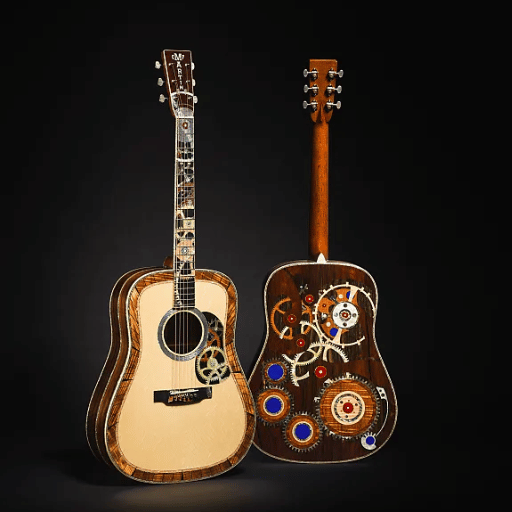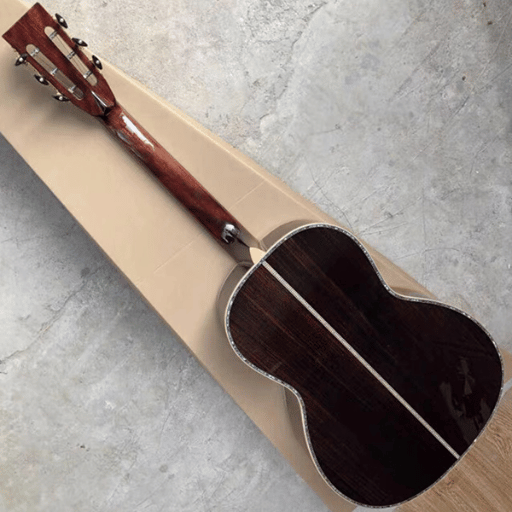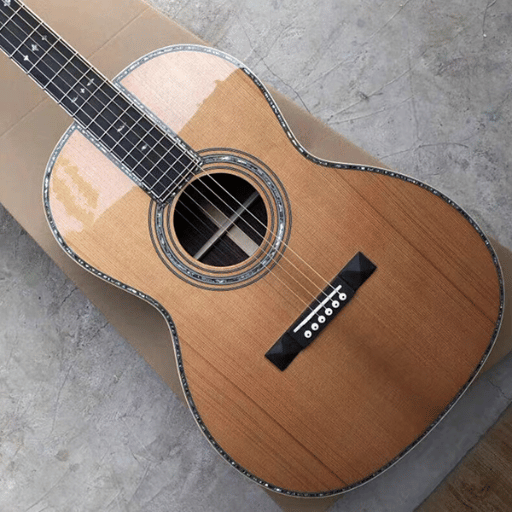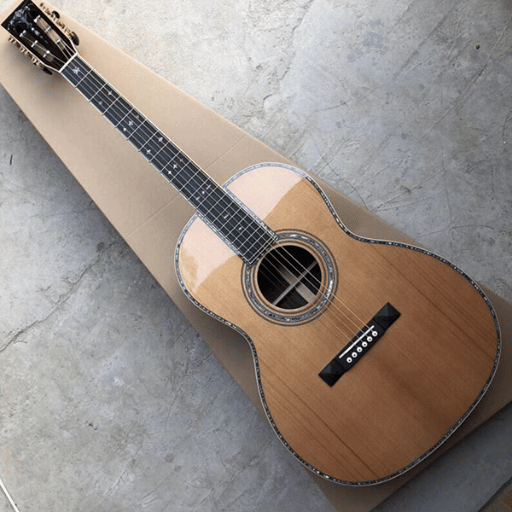How to Choose the Best Martin Guitar for Your Style and Skill Level
If you're a guitar enthusiast, chances are you've heard of Martin guitars. With over 180 years of experience in crafting high-quality instruments, Martin is a brand that is renowned among guitarists for its exceptional sound and craftsmanship. Whether you're a beginner or a seasoned player, choosing the right Martin guitar is crucial to enhancing your playing experience and taking your skills to the next level.
When it comes to selecting a Martin guitar, there are several factors to consider. Your playing style, skill level, and budget are just a few of the many variables that should be taken into account. In this guide, we'll take a closer look at these factors and provide tips on how to choose the best Martin guitar for your needs.
So why is choosing the right Martin guitar so important? Firstly, the type of guitar you play can greatly impact the sound and style of music you create. Different models of Martin guitars are designed to produce various tones and are better suited for certain genres of music. Additionally, a guitar that is comfortable and easy to play can make all the difference in your performance and practice sessions. By selecting the right Martin guitar, you can improve your playing abilities and reach your full potential as a musician.
In the following sections, we'll dive deeper into the factors to consider when selecting a Martin guitar, overview the various models available, and provide tips on testing and evaluating guitars in-person and online. Let's get started.

Factors to consider when choosing the best Martin guitar for you
Choosing the best Martin guitar for your needs requires careful consideration of several factors. Here are three key factors to keep in mind:
1. Your playing style and genre preferences
The first factor to consider when choosing a Martin guitar is your playing style and the type of music you enjoy playing. Certain Martin guitar models are better suited for specific genres, such as folk, blues, or country. For example, the Martin D-28 is a classic acoustic guitar that is popular among bluegrass and folk musicians, while the Martin OM-21 is favored by fingerstyle guitarists.
Consider the sound you want to achieve and the type of music you play most frequently. This will help you narrow down your options and choose a Martin guitar that complements your playing style.
2. Your skill level and experience as a guitarist
Another important factor to consider when choosing a Martin guitar is your skill level and experience as a guitarist. If you're a beginner, you may want to choose a guitar that is easier to play and forgiving on mistakes. The Martin LX1 Little Martin, for example, is a smaller-sized guitar that is great for beginners and those with smaller hands.
On the other hand, if you're an experienced guitarist, you may want a guitar with a more advanced sound and features. The Martin D-45, for instance, is a high-end guitar with intricate details and luxurious materials that is favored by professional musicians.
3. Your budget and price range
Your budget is also an important factor to consider when choosing a Martin guitar. Martin guitars range in price from a few hundred dollars to tens of thousands of dollars. While it's always tempting to go for the most expensive option, it's important to choose a guitar that fits your budget and provides the best value for your money.
Consider the features and specifications of each guitar model within your price range and choose one that best meets your needs. It's also important to factor in additional costs such as accessories and maintenance when budgeting for your guitar purchase.
By considering these three factors - your playing style and genre preferences, your skill level and experience, and your budget and price range - you can make an informed decision and choose the best Martin guitar for your needs.
Overview of Martin guitar models and their features
Martin offers a wide variety of guitar models, each with unique features and specifications that cater to different playing styles and skill levels. Here's a brief overview of some of the most popular Martin guitar models and their features:
1. Martin D-28
The Martin D-28 is one of the most iconic acoustic guitars of all time. This dreadnought-shaped guitar has a rich and balanced tone that is ideal for a variety of genres, from folk and country to rock and blues. It features a solid Sitka spruce top, solid East Indian rosewood back and sides, and a mahogany neck with an ebony fingerboard. The D-28 is often favored by professional musicians and has been used on countless recordings.
2. Martin OM-21
The Martin OM-21 is a versatile guitar that is favored by fingerstyle guitarists. This orchestra model guitar has a smaller body size than the D-28, which results in a more focused and articulate sound. The OM-21 features a solid Sitka spruce top, solid East Indian rosewood back and sides, and a select hardwood neck with an ebony fingerboard. It's a great choice for players who want a guitar that is comfortable to play and can handle a variety of genres.
3. Martin HD-28
The Martin HD-28 is similar in design to the D-28 but has a few key differences. It features scalloped bracing, which enhances the guitar's bass response and overall volume. The HD-28 also has herringbone purfling and a tortoise pickguard, which give it a distinctive look. The HD-28 is a great choice for players who want the classic D-28 sound but with a bit more projection and punch.
4. Martin 000-15M
The Martin 000-15M is a small-bodied guitar that is favored by blues and folk musicians. This guitar has a warm and balanced tone that is ideal for fingerpicking and strumming. The 000-15M features a solid mahogany top, back, and sides, and a simple satin finish. It's a great choice for players who want a guitar with a vintage-inspired look and feel.
5. Martin D-15M
The Martin D-15M is a dreadnought-shaped guitar that is similar in design to the D-28 but with a more affordable price tag. This guitar has a warm and mellow tone that is ideal for fingerpicking and strumming. The D-15M features a solid mahogany top, back, and sides, and a simple satin finish. It's a great choice for players who want a solid wood guitar at a more affordable price.
These are just a few of the many Martin guitar models available. Other popular models include the Martin D-45, Martin 000-28EC, Martin CEO-7, and Martin 00-15E. Each model has its own unique features and specifications that cater to different playing styles and preferences. When choosing a Martin guitar, it's important to consider which model will best suit your needs and enhance your playing experience.
How to test and evaluate Martin guitars in-person
When it comes to buying a Martin guitar, it's important to test and evaluate the instrument in person. Here are some tips on how to test and evaluate Martin guitars in-person:
1. Check the guitar's playability
One of the most important aspects of a guitar is how easy it is to play. Check the guitar's action (the distance between the strings and the fretboard) to ensure that it's comfortable and easy to play. You should also check the guitar's intonation (how in tune it is across the fretboard) by playing chords and individual notes up and down the neck.
2. Evaluate the guitar's sound quality
The sound quality of a guitar is perhaps the most important factor to consider when choosing a Martin guitar. Play a variety of chords and notes to evaluate the guitar's sound quality. Listen for a clear and balanced tone, good sustain, and even volume across all strings.
3. Inspect the guitar's condition and craftsmanship
Carefully inspect the guitar's condition and craftsmanship. Look for any visible cracks, scratches, or dings on the guitar's body, neck, and headstock. Check the guitar's tuning machines to ensure that they're functioning properly. You should also check the quality of the guitar's finish and binding, and inspect the frets for any signs of wear or damage.
4. Ask the seller or retailer questions
If you're purchasing a guitar from a retailer or private seller, don't be afraid to ask questions. Ask about the guitar's history, how often it was played, and if any repairs or modifications have been made. You should also ask about the guitar's warranty and return policy.
5. Compare different Martin guitar models
If possible, try out several different Martin guitar models to compare their sound, feel, and playability. This can help you determine which model is best suited for your playing style and preferences.
Overall, testing and evaluating Martin guitars in-person is an essential step in choosing the right instrument. By following these tips and taking the time to try out several different models, you can make an informed decision and choose a Martin guitar that meets your needs and enhances your playing experience.
Online resources and reviews for choosing the best Martin guitar
In addition to testing and evaluating Martin guitars in-person, there are also many online resources and reviews available that can help you choose the best Martin guitar for your needs. Here are some tips on how to use online resources and reviews to help you make an informed decision:
1. Research guitar forums and websites
Guitar forums and websites are great resources for researching Martin guitars. Websites such as Reverb, Sweetwater, and Guitar Center have comprehensive listings of Martin guitars with detailed descriptions and specifications. Guitar forums such as The Gear Page and Harmony Central have discussions about Martin guitars and user reviews. These resources can help you get a sense of the different Martin guitar models available and their features.
2. Read reviews and testimonials from other guitarists
Reading reviews and testimonials from other guitarists can also be helpful when choosing a Martin guitar. Websites such as Amazon and Sweetwater have user reviews for most Martin guitar models. These reviews can provide insights into the guitar's sound quality, playability, and overall value. You can also look for reviews and testimonials from professional musicians who have experience playing Martin guitars.
3. Consider video demos and reviews
Video demos and reviews on websites such as YouTube can also be a valuable resource when researching Martin guitars. You can see and hear the guitar being played and get a sense of its sound quality and tone. Many guitarists and music retailers have posted video reviews of Martin guitars, which can provide additional insights into the guitar's features and playability.
4. Interpret and evaluate online reviews and ratings
When reading online reviews and ratings, it's important to interpret and evaluate them with a critical eye. Look for reviews that are detailed and specific, and avoid reviews that are overly vague or emotional. Keep in mind that not all reviews are objective, and some may be biased or manipulated. Look for patterns in the reviews to get a sense of the overall consensus about a particular Martin guitar model.
By using online resources and reviews in combination with testing and evaluating Martin guitars in-person, you can make an informed decision and choose the best Martin guitar for your needs.
Martin guitar customization options and upgrades
Martin guitars are known for their exceptional quality and craftsmanship, but there are also several customization options and upgrades available that can enhance your playing experience. Here are some customization options and upgrades to consider for your Martin guitar:
1. Changing the strings
Changing the strings on your Martin guitar can make a big difference in its sound and playability. Different types of strings, such as bronze or phosphor bronze, can produce different tones and levels of brightness. Experiment with different string types and gauges to find the ones that best suit your playing style and preferences.
2. Upgrading the tuning machines
Upgrading the tuning machines on your Martin guitar can improve its tuning stability and make it easier to stay in tune. There are several high-quality tuning machine brands available, such as Schaller and Gotoh, that can be installed on your guitar.
3. Installing a pickup system
If you plan to play your Martin guitar through an amplifier or PA system, installing a pickup system can be a valuable upgrade. Many aftermarket pickup systems are available, such as the LR Baggs Anthem or Fishman Matrix, that can be installed without damaging the guitar's original design or sound.
4. Customizing the inlays or pickguard
Customizing the inlays or pickguard on your Martin guitar can give it a unique and personalized look. Many luthiers and guitar technicians offer custom inlay and pickguard services that can add a personal touch to your guitar.
5. Upgrading the bridge pins and saddle
Upgrading the bridge pins and saddle on your Martin guitar can improve its sustain and tone. There are several high-quality bridge pins and saddle materials available, such as bone and Tusq, that can be installed on your guitar.
6. Adding a strap button
If your Martin guitar doesn't have a strap button installed, adding one can make it easier to play while standing up. Many luthiers and guitar technicians can install a strap button without damaging the guitar's original design or sound.
By customizing and upgrading your Martin guitar, you can enhance its sound and playability to better suit your needs and preferences. Consult with a reputable luthier or guitar technician to determine which upgrades are right for your guitar and playing style.
Care and maintenance for your Martin guitar
Taking good care of your Martin guitar is essential to keeping it in top condition and ensuring that it continues to sound and play great. Here are some tips for caring for and maintaining your Martin guitar:
1. Keep your guitar clean
Regularly cleaning your guitar is an important part of maintaining its appearance and prolonging its lifespan. Use a soft cloth to wipe down the guitar's body, neck, and strings after each use. Avoid using harsh cleaning products or chemicals that can damage the guitar's finish.
2. Store your guitar properly
Storing your guitar properly is important to prevent damage and ensure that it stays in tune. Always store your guitar in a dry and cool place, away from direct sunlight and extreme temperatures. Use a guitar case or gig bag to protect your guitar during transportation.
3. Check and adjust the guitar's neck relief
The neck relief refers to the amount of curvature in the guitar's neck. Checking and adjusting the neck relief is important to ensure that the guitar plays properly and stays in tune. Use a capo and a feeler gauge to check the neck relief, and adjust it as necessary using the truss rod.
4. Keep the guitar's frets clean and smooth
Clean and smooth frets are essential to ensure that the guitar plays properly and produces clear notes. Use a fretboard cleaner and a microfiber cloth to clean the guitar's frets, and use a fret file or polishing cloth to smooth out any rough spots or burrs.
5. Change the guitar's strings regularly
Regularly changing your guitar's strings is important to maintain its tone and playability. Change the strings every 3-6 months, or more frequently if you play frequently or perform regularly. Be sure to stretch the strings after installing them to ensure that they stay in tune.
6. Have your guitar professionally serviced
Regularly having your guitar professionally serviced is important to keep it in top condition and catch any potential issues before they become major problems. Have your guitar serviced annually by a reputable luthier or guitar technician who can perform tasks such as adjusting the neck, setting the action, and replacing worn parts.
By following these care and maintenance tips, you can ensure that your Martin guitar stays in top condition and continues to sound and play great for years to come.

Conclusion and final thoughts on choosing the best Martin guitar for you
Choosing the best Martin guitar for your needs and preferences can be a daunting task, but it's also an exciting opportunity to invest in an instrument that you'll enjoy playing for years to come. Here are some final thoughts and tips to help you make a wise purchase decision:
1. Consider your playing style and preferences
When choosing a Martin guitar, it's important to consider your playing style and preferences. Think about the genres of music you like to play, as well as your skill level and experience as a guitarist. This will help you determine which Martin guitar models are best suited for your needs.
2. Test and evaluate guitars in-person
Testing and evaluating Martin guitars in-person is essential to ensuring that you choose the right instrument. Take the time to try out several different models and compare their sound, feel, and playability.
3. Use online resources and reviews as a supplement
Online resources and reviews can be a helpful supplement to testing and evaluating guitars in-person, but they shouldn't be relied on exclusively. Use online resources and reviews to research different Martin guitar models and get a sense of their features and specifications.
4. Consider customization options and upgrades
Customization options and upgrades can enhance your Martin guitar's sound and playability to better suit your needs and preferences. Consult with a reputable luthier or guitar technician to determine which upgrades are right for your guitar and playing style.
5. Take good care of your Martin guitar
Taking good care of your Martin guitar is essential to ensuring that it stays in top condition and continues to sound and play great. Clean and store your guitar properly, and have it professionally serviced on a regular basis.
By following these tips and taking the time to choose the right Martin guitar for your needs, you can invest in an instrument that will bring you joy and inspiration for years to come.
FAQs on choosing the best Martin guitar
Here are some common questions and concerns that guitarists have when choosing a Martin guitar:
1. What makes Martin guitars so special?
Martin guitars are known for their exceptional quality and craftsmanship. They're made with high-quality materials and construction techniques that produce a rich, balanced tone and excellent playability. Martin guitars have been played by some of the world's greatest musicians, and they have a reputation for lasting for decades or even generations.
2. How do I choose the right Martin guitar for my playing style?
Choosing the right Martin guitar for your playing style involves considering factors such as the genres of music you like to play, your skill level and experience as a guitarist, and your budget. Test and evaluate several different Martin guitar models in-person to get a sense of their sound and playability, and consider customization options and upgrades to better suit your needs and preferences.
3. How can I negotiate a better price for a Martin guitar?
Negotiating a better price for a Martin guitar involves doing your research and being prepared to walk away if you can't get a fair price. Research the guitar's value and condition, and use this information to negotiate with the seller or retailer. Be respectful and professional in your negotiations, and don't be afraid to walk away if you can't get a fair deal.
4. How can I identify a counterfeit Martin guitar?
Identifying a counterfeit Martin guitar can be difficult, but there are several warning signs to look out for. Counterfeit Martin guitars often have poor craftsmanship, low-quality materials, and incorrect logos or labels. If you're unsure about the authenticity of a Martin guitar, have it inspected by a reputable luthier or guitar technician.
5. How can I ensure that I'm making a wise purchase decision?
Ensuring that you're making a wise purchase decision involves doing your research, testing and evaluating guitars in-person, and being prepared to invest in a high-quality instrument. Consult with a reputable luthier or guitar technician, and take good care of your Martin guitar to ensure that it stays in top condition and continues to sound and play great.
Martin guitar comparison chart by model
Here is a comparison chart of popular Martin guitar models and their features:
| Model | Body Size | Top Wood | Back and Sides Wood | Neck Wood | Fingerboard Wood | Scale Length | Nut Width | Electronics |
|---|---|---|---|---|---|---|---|---|
| D-28 | Dreadnought | Sitka Spruce | East Indian Rosewood | Mahogany | Ebony | 25.4" | 1.75" | Optional |
| D-18 | Dreadnought | Sitka Spruce | Mahogany | Mahogany | Ebony | 25.4" | 1.75" | Optional |
| OM-28 | Orchestra | Sitka Spruce | East Indian Rosewood | Mahogany | Ebony | 25.4" | 1.75" | Optional |
| 00-18 | Auditorium | Sitka Spruce | Mahogany | Mahogany | Ebony | 24.9" | 1.75" | Optional |
| 000-28EC | Auditorium | Sitka Spruce | East Indian Rosewood | Mahogany | Ebony | 24.9" | 1.75" | Optional |
| GPC-16E | Grand Performance | Sitka Spruce | Sycamore | Select Hardwood | Ebony | 25.4" | 1.75" | Yes |
| D-35 | Dreadnought | Sitka Spruce | East Indian Rosewood | 3-Piece Back | Ebony | 25.4" | 1.75" | Optional |
| LX1E Little Martin | Mini | Sitka Spruce | Mahogany | Rust Birch Laminate | FSC Certified Richlite | 23" | 1.69" | Yes |
| 000-15M | Auditorium | Mahogany | Mahogany | Mahogany | Rosewood | 25.4" | 1.75" | No |
| GPC-X2E | Grand Performance | Sitka Spruce | HPL | Stratabond | FSC Certified Richlite | 25.4" | 1.75" | Yes |
Pros and cons of each model for different playing styles and skill levels
D-28
Pros:
- Powerful and balanced tone
- Excellent projection and volume
- Popular choice for bluegrass and country players
Cons:
- Heavier and bulkier than some other Martin models
- May not be as comfortable for smaller or more petite players
Best suited for:
- Intermediate to advanced players who value power and projection
D-18
Pros:
- Clear and balanced tone
- Comfortable and versatile
- Good choice for fingerstyle and strumming
Cons:
- May lack some of the power and projection of other Martin models
Best suited for:
- Intermediate players who want a versatile and comfortable guitar
OM-28
Pros:
- Clear and balanced tone
- Comfortable and easy to play
- Good choice for fingerstyle and light strumming
Cons:
- May lack some of the power and projection of other Martin models
Best suited for:
- Intermediate players who want a comfortable and versatile guitar
00-18
Pros:
- Clear and

